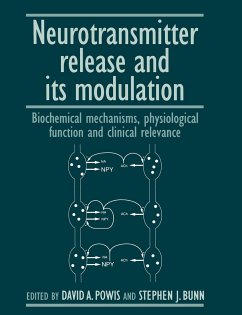The group of chemicals known collectively as neurotransmitters form the basis of a complex communication system between nerve cells. It is a system which is constantly subtly refined and regulated via the modulating action of other neurotransmitters, circulating hormones, the products of local tissues and the action of various drugs (from both medicinal and socially abused sources). Within this book, acknowledged authorities concisely describe the basic mechanisms involved in neurotransmitter release modulation in the different parts of the nervous system. This includes a quantitative evaluation of the significance of modulation, and a summary of both its biological ramifications and potential clinical relevance. The clear illustrations and descriptions create a valuable and easy to use reference resource for the non-specialist reader and neuroscientist alike. Clinicians, researchers and students should all find its contents of interest.
Table of contents:
Part I. Neurotransmitter Release: 1. Mechanisms of exocytosis and the central role of calcium; 2. Co-transmission; 3. Models and mechanisms of neurotransmission; Part II. Modulation of Neurotransmitter Release: Basic Principles and Key Players: 4. Modulation of neurotransmitter release; 5. Modulation by autoreceptors; 6. Modulation by heteroreceptors; 7. Modulation by hormones and local tissue factors; 8. Modulation by corticosteroid hormones; Part III. Modulation of Neurotransmitter Release: The Cellular Mechanisms Involved: 9. Second messenger pathways in the modulation of neurotransmitter release; 10. Regulation of calcium influx as a basis for modulation; 11. Calcium-independent modulation; Part IV. Modulation of Neurotransmitter Release: Physiological Function: 12. In vivo evidence for presynaptic modulation; 13. Modulation of secretion from neurosecretory cells; Part V. Modulation of Neurotransmitter Release: Clinical Relevance: 14. Possible role of presynaptic receptors in hypertension; 15. Monoamine neurones and antidepressant treatments; 16. Modulation of neurotransmitter release by some therapeutic and socially-used drugs; 17. Beneficial therapeutic interventions via manipulation of presynaptic modulatory mechanisms.
Acknowledged authorities concisely describe the basic mechanisms involved in neurotransmitter release modulation, its biological significance and its clinical relevance. The clear illustrations and descriptions create a valuable and easy to use reference resource for both the non-specialist reader and neuroscientist alike.
A uniquely comprehensive and integrated account of neurotransmitter modulation. Suitable for neuroscientists and non-specialists alike.
Table of contents:
Part I. Neurotransmitter Release: 1. Mechanisms of exocytosis and the central role of calcium; 2. Co-transmission; 3. Models and mechanisms of neurotransmission; Part II. Modulation of Neurotransmitter Release: Basic Principles and Key Players: 4. Modulation of neurotransmitter release; 5. Modulation by autoreceptors; 6. Modulation by heteroreceptors; 7. Modulation by hormones and local tissue factors; 8. Modulation by corticosteroid hormones; Part III. Modulation of Neurotransmitter Release: The Cellular Mechanisms Involved: 9. Second messenger pathways in the modulation of neurotransmitter release; 10. Regulation of calcium influx as a basis for modulation; 11. Calcium-independent modulation; Part IV. Modulation of Neurotransmitter Release: Physiological Function: 12. In vivo evidence for presynaptic modulation; 13. Modulation of secretion from neurosecretory cells; Part V. Modulation of Neurotransmitter Release: Clinical Relevance: 14. Possible role of presynaptic receptors in hypertension; 15. Monoamine neurones and antidepressant treatments; 16. Modulation of neurotransmitter release by some therapeutic and socially-used drugs; 17. Beneficial therapeutic interventions via manipulation of presynaptic modulatory mechanisms.
Acknowledged authorities concisely describe the basic mechanisms involved in neurotransmitter release modulation, its biological significance and its clinical relevance. The clear illustrations and descriptions create a valuable and easy to use reference resource for both the non-specialist reader and neuroscientist alike.
A uniquely comprehensive and integrated account of neurotransmitter modulation. Suitable for neuroscientists and non-specialists alike.








